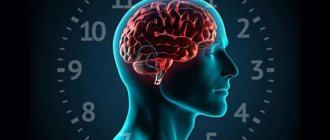The unconscious fear of being in a public place without being able to leave, or of being in a situation in which panic or anxiety may develop, is called agoraphobia. What is this? The answer is: a severe mental illness of the neurotic spectrum, related to anxiety-phobic disorders, the so-called fear of open spaces. To put it simply, along with other phobias, this is also a type of neurosis.
Necessary and not so necessary information
The name “agoraphobia” comes from the merger of the Greek words ἀγορά (agora), which means “market,” and φόβος (phobos), which means “fear.” The term appeared in 1871. Previously, such pathology was considered by specialists as a manifestation of generalized anxiety. This was the case until 1980, when, based on many years of observations, it was concluded that these disorders are caused by different reasons and differ in development and response to therapy.
Fear has been living in us since the appearance of the second, it is as ancient as the very existence of homosapiens. It is based on biology and physiology, so it is very simple to justify. A man, leaving the thicket of a forest into an open space, was afraid to encounter something unknown that could threaten his life, and he had no opportunity to hide. And when global migration and clashes between tribes began, the fear of a crowd appeared, in which anyone could be injured or trampled. All this remains in our genetic memory.
Now it is clear that agoraphobia is two types of fear: panic in a crowded place and discomfort in an open area. Sometimes it is called fear of life: a person suffering from it feels calm only in his own home, he seems to be locking himself in - he cannot go to work, buy groceries, visit a museum or concert. He is not able to be on a subconscious level where everything is “seething”. A patient may experience a panic attack:
- in a market or store full of people;
- on an empty street;
- at public transport stops and inside it;
- at a rally, stadium, parade;
- in the auditorium;
- indoors with open doors and windows, etc.
Even in the hairdresser's chair, such a person can panic! And the point here is not that in some cases there is no open space and a large mass of people, but in accessibility, the lack of opportunity to escape and hide unnoticed.
The prevalence of agoraphobia has made it popular in the creative community: there are, for example, quite a lot of musical works on this topic. Cinema did not stand aside either: the plot of such films as the Russian “Closed Spaces”, the Canadian “Frozen in Fear”, the Belgian “Tom in Love”, the Italian “Best Offer”, the American “Imitator”, etc. is based on it.
Among the famous actors there were and are agoraphobes: Marilyn Monroe, who died early, Macaulay Kalin, Daryl Hannah, Kim Bassinger, as well as the notorious director Woody Allen. This disease has brought and continues to bring a lot of troubles and difficulties to all of them.
What is agoraphobia?
Agoraphobia is a state of increased anxiety that can be caused by:
- the need to stay and move outside the home;
- staying in public places and using public transport;
- deserted open space (park, field, empty square, etc.);
- places where large numbers of people gather (markets, shops, demonstrations);
- the need for independent travel;
- places that cannot be left unnoticed (a doctor’s or hairdresser’s chair, a theater or cinema hall).
These places are united by the fear of a judgmental reaction from people around them in the event of inappropriate behavior or a panic attack. The fear of panic reactions in public places increases internal tension, due to which ordinary fears acquire a phobic character. Panic attacks are associated not only with the assessment of others, but also with one’s own sense of self, the need to control the situation. For example, a person may fear freezing, being trapped, having a heart attack, being attacked, or experiencing other negative events that cannot be controlled outside the home. When fear is associated with social contacts, there may be not only an avoidance of large numbers of people around, but also close interaction in private. For example, even when receiving guests, a person with agoraphobia will avoid eye contact and fall into a confused state of panic if there is any. If the fear is more related to the terrain, it can be regulated by the distance limits where the person is comfortable. This could be the territory of your own apartment. It may also include neighboring stores - it all depends on the individual. In the most severe cases, a person is unable to leave his home, so he orders food and clothes on the Internet and limits contact with the outside world as much as possible.
Reasons for appearance
Experts cannot name the main “culprit” for the development of agoraphobia. It is believed that the root cause is a panic attack, which turns into an anxiety disorder. Others believe the diametrically opposite: first a fear of open spaces appears, and panic attacks “follow” from it. A compromise between these theories has not yet been achieved, but one thing is clear - these pathologies are very closely related.
Sigmund Freud's concept
The founder of psychoanalysis proposed his concept of the development of agoraphobia and other anxiety disorders: since they are all neurotic pathologies (neuroses), their origin is at the psychogenic level.
Freud believed that the main symptom of the disease, anxiety, is the result of an intrapersonal conflict that arose in childhood or adolescence, a compromise between the drive (“it”) and the prohibition on this desired (“superego”). This, in turn, transforms into sensations such as tremor, shortness of breath, and suffocation.
Academician Pavlov's theory
The great physiologist considered any fear to be a conditioned reflex. That is, if some incident occurs to an individual or a person close to him, causing fear, then when he finds himself in such a situation, the brain begins to “sound the alarm.” Over time, growing like a snowball, such fear transforms into agoraphobia. But one can argue with this: not all people who have experienced trouble in a crowd get sick, and on the contrary, the disorder develops in those who have not had such cases.
Is the vestibular apparatus to blame for everything?
Not so long ago, research results appeared claiming that it is problems with the vestibular apparatus that are responsible for agoraphobia. It is located in the inner ear, in the bony labyrinth, and its functional duty is to orient the movement of the human head and body. That is, the signals from the visual-muscular system and the vestibular apparatus must be balanced. However, problems with the latter do not allow agoraphobes to normally perceive tactile sensations from a surface and visually clearly see objects. This disorientation leads to agitation and a panic attack.
Agoraphobia in Russian psychiatry was predominantly considered within the framework of obsessive-compulsive neurosis (5,11). However, at present, taking into account international experience and the spread of new classifications of mental disorders, the tendency towards nosographic differentiation of obsessions is becoming more and more definite.
Thus, panic and obsessive-compulsive disorders, simple phobias, and social phobias were identified. A relationship has been established between phobic conditions, affective, somatoform disorders, as well as behavioral syndromes associated with physiological disorders (2,14).
In the context of these changes, the qualification of agoraphobia as an independent disorder that unites previously distinct cases of obsessive fears of open and closed spaces seems justified (9, 19).
In recent decades, diagnostic criteria for agoraphobia have been developed, on the basis of which a series of studies have been conducted on the prevalence and comorbidity of this disorder (17,21). Nevertheless, a number of aspects of the agoraphobia clinic remain open. Among them is the question of the syndromic structure of this disorder, its dynamics, as well as the personal characteristics of these patients.
This report summarizes the data from a study of a group of patients with agoraphobia syndrome (68 people). Selection into it was made according to ICD-10 criteria and was based on the patient’s statement of unreasonable fear that arises in crowds, public places, situations associated with being or moving alone, or moving outside the home. To qualify the syndrome, it was also necessary to establish the patient’s tendency to avoid these situations and maintain a critical attitude towards existing disorders.
The majority of the group were women (54 people). The age of patients ranged from 17 to 64 years (average 35 years). 48 of them were married, 20 were single, including 5 divorced. Despite the high educational level (30 patients had higher and 38 incomplete higher or secondary education), only 18 patients worked, and 19 were only part-time employed. The diagnosis of agoraphobia was the main one in 59 cases. In 11 patients, this diagnosis was established as an additional diagnosis against the background of recurrent depressive disorder (5 people), bipolar affective disorder (3 people), a single affective episode (2 people) and organic brain damage (1 person). Agoraphobia in schizophrenia was not included in the study. In 59 patients the condition was classified as agoraphobia with panic disorder, and in 9 as agoraphobia without panic disorder. The duration of the disease in all examined patients was at least 1 year (from 1 to 3 years - 36 people, from 4 to 10 years - 24 people, more than 10 years - 8 people). All patients had previously consulted specialists for existing disorders, 35 of them were hospitalized in psychiatric hospitals, 13 more than once.
A psychopathological analysis of the condition of the examined patients showed that the clinical manifestations of agoraphobia are very polymorphic and dynamic. At the same time, symptoms corresponding to the operational criteria of ICD-10 are necessary, but not sufficient for a detailed clinical description of this disorder. For this purpose, it is advisable to supplement the operational approach by considering the entire set of disorders identified in patients with agoraphobia in the structure of the major psychopathological syndrome (10). This makes it possible to study the clinical picture of agoraphobia both statically and dynamically, as well as to evaluate the characteristics of the soil in which the disorder arose.
As the study of the condition of patients shows, the psychopathological structure of agoraphobia in static conditions has basic and additional components. The main ones include agoraphobic disorders, somatoform symptoms, and affective disorders. Additional ones include other anxiety disorders and drive disorders. The agoraphobic symptom complex itself includes situationally determined anxiety-vegetative paroxysms and the so-called phobic avoidance (20). Anxiety-vegetative attacks in the examined patients occurred in situations, the common feature of which was the presence of spatial barriers (distance, partitions, obstacles, etc.). The fear that arises during these attacks was specific in nature and was usually associated by patients with a feeling of impending death or madness. It is important that it was preceded by a feeling of helplessness that gripped patients in a phobic situation. Depersonalization-derealization episodes and psychomotor agitation were often observed. This picture was complemented by protruding and polymorphic vegetative disorders in the form of palpitations, sweating, tremor, shortness of breath, vasomotor reactions, etc.
In their most extensive form, anxiety-vegetative paroxysms were observed in the variant of agoraphobia with panic disorder. Their peculiarity, in our opinion, was the absence or insignificant severity of intrapunitive experiences (embarrassment, shame, guilt), which usually accompany paroxysms of fear in “pure” panic disorder, as well as their comparatively lower overall intensity. In the variant of agoraphobia without panic disorder, no extensive anxiety-vegetative paroxysms were observed. However, in many cases, these patients also experienced low-symptomatic paroxysmal vegetative changes, accompanied by emotional tension or episodes of asthenia.
Phobic avoidance is another important manifestation of the agoraphobic symptom complex. This symptom is its objective behavioral characteristic, which largely determines the severity of the patient’s condition. It lies in the tendency of these individuals to avoid contact with a situation that frightens them, not to talk about it or remember it. As observations showed, as a result of the difficulties that arose among the studied patients with going out into the street, traveling in transport, and the need to remain alone, a significant part of them (42 people) were seriously disabled. They found themselves unable to fulfill family and professional responsibilities, and their contact with others was significantly limited. At the same time, the severity of avoidance did not depend on the intensity of anxiety-vegetative paroxysms, but was determined by the feeling of inability to perform the necessary actions or receive adequate help if health deteriorated.
Somatoform symptoms occupy a significant place in the structure of agoraphobic states. The studied patients consistently (91%) complained of a variety of bodily sensations, often arising or intensifying during anxiety-vegetative paroxysms. Among them, algias predominated, and sometimes baric or thermal sensations. In most cases, sensations were limited in duration and localization and were not subject to conceptual processing. However, in approximately 30% of patients, somatophoric symptoms were more stable, bodily sensations acquired a generalized nature, senestopathy and hypochondriacal tendencies. In such observations, we were talking about a combination of agoraphobia with various types of somatoform disorders.
With a high frequency (74%), patients with agoraphobia had affective disorders corresponding to mixed anxiety and depressive disorder (27 people), as well as mild or moderate affective episodes (23 people) according to ICD-10. In 39 cases, these conditions were classified as secondary depression, since they arose in connection with agoraphobic symptoms, occupied a subordinate position in the clinical picture and were determined by situational factors. However, along with this, the described patients also had primary depression (6 people), erased episodes of mixed states (3 people) and hypomania (2 people).
Along with the named main components of the major agoraphobic syndrome, a number of patients had additional psychopathological manifestations: specific phobias (18 people), social phobias (9 people), generalized anxiety (10 people), alcoholism (13 people), bulimia (6 people .) etc. These disorders, not being obligate components of the syndrome, are nevertheless often combined with agoraphobia (17). Clinically, the features of the course of agoraphobia are of significant importance. Observations show that in the overwhelming majority of cases, the manifestation of the disease is associated by the patients themselves with anxiety-vegetative paroxysms, which are usually accompanied by phobias for a short time. However, an in-depth analysis of anamnestic data allows us to establish that in the premorbid period of patients, subclinical affective fluctuations, abnormal personality reactions, or behavioral disorders were often noted. They usually preceded the occurrence of anxiety-vegetative paroxysms and were accompanied by a sharpening of personality traits, adaptation disorders, and antisocial manifestations. As a rule, there were protracted stressful situations associated with family conflicts, migration, difficulties in personal life or at work. A very typical situation was the “social mousetrap”, in which patients had to significantly change their life pattern in order to achieve a certain social stability and security.
The key thing for patients in such situations was the difficult-to-tolerate subjective feeling of complete dependence on external circumstances and the associated difficulties in maintaining their identity. It should be especially emphasized that in approximately a quarter of observations, agoraphobic states developed against the background of cessation of alcohol abuse or as part of bulimia nervosa.
As for the dynamics of agoraphobic symptoms themselves, in accordance with the identified (1) types of course in the examined patients, in 72% one could speak of a continuous course, and in 28% of a recurrent course of agoraphobia. A recurrent course was observed when agoraphobia occurred against the background of recurrent and bipolar affective disorder. At the same time, this type of course might not be combined with mood disorders. Intermissions in these cases were usually due to the therapy being carried out or a change in the microsocial situation.
With a continuous type of course, the clinical picture was more complex. Secondary depression, concomitant somatoform disorders, as well as the above-mentioned additional psychopathological manifestations were consistently observed. This variant of the course usually developed in conditions of chronic psychogenicity in patients with severe personality anomalies. However, even here, with adequate treatment, including psychotherapy, or a favorable change in the situation, the patients’ condition could significantly improve.
The emergence of abnormal personal reactions in premorbid patients, the nature of the dynamics of agoraphobia, the role of psychogenics, as well as the reflection of key experiences in the clinical picture indicate the need to assess their personal characteristics. The results of the examination of these patients indicate a significant frequency of personality anomalies. The latter in 36 patients met the ICD-10 criteria for personality disorders, i.e. they were found in several mental areas, were stable, deep, formed at an early age, manifested themselves in a wide range of situations and caused disturbances in social adaptation already in premorbidity. In 32 patients, personality anomalies were classified as stable accentuations of character (6,7), since they were not deep and did not significantly affect the general level of social adaptation of the patients.
Depending on the characterological type, patients with personality disorders and accentuations, respectively, were distributed as follows: emotionally unstable (44%) - 21 and 9 people, evaders (19%) - 5 and 8 people, anancastic (18%) - 3 and 9 people, histrionic (8%) - 2 and 6 people, dependent (7%) - 5 people. (personality disorder only). When considering these data, it should be emphasized that they are in good agreement with the opinion of Hoffart (16) about the connection of agoraphobia with those types of personality deviations that are included in the classes of dramatic and anxious according to DSM-III-R. That is, in some patients (emotionally unstable, histrionic) expansive forms of response predominated, combined with insufficient controllability of behavior, demonstrativeness, affective lability and instability of preferences. For others (evaders, anankastes, dependents), self-limiting tendencies with hypertrophied self-control, excessive caution, adherence to social stereotypes and avoidance of responsibility came first. It is important to note that the same patient could have both of these tendencies, and only the comparative predominance of one of them determined the clinical personality type.
Along with the pathocharacterological features, when examining patients with agoraphobia, attention was drawn to other manifestations of personality anomalies, which, in our opinion, are of paramount importance for the clinic of agoraphobia. This includes a wide and relatively little-studied range of deviations associated with impaired cognitive processes, described in psychopaths as the phenomenon of partial uncriticality (3,12). These anomalies consist in the peculiarities of perception and interpretation of events, the formation of motives and relationships, changes in self-awareness and self-esteem. These changes in the examined patients were manifested by an affectively determined distortion of thinking, which was most clearly expressed in their inherent catastrophism. This feature is pointed out by a number of authors (15, 18). It is most clearly revealed in moments of contact with a phobic situation, when patients begin to interpret the slightest changes in their condition or environment in an unfavorable and threatening sense.
However, catastrophism in the examined patients was also found in behavior that was not related to phobic situations. It manifested itself in a tendency to “self-intimidation,” “self-restraint,” and exaggeration of life’s difficulties. The noted features were combined with so-called “black and white thinking,” as well as difficulties in understanding and expressing experienced feelings and drives. Moreover, the greatest difficulties for patients with agoraphobia arose in situations related to awareness and open manifestation of expansiveness. Taking into account the above, there is no doubt that here we are talking about the stylistic features of the organization of cognitive processes that characterize the personality.
Thus, the study indicates that agoraphobia is characterized by a complex and dynamic psychopathological structure, in which phobic symptoms themselves do not occur in isolation, but are combined with a wide range of somatoform, affective and other anxiety disorders. In addition, in patients of this category, personality anomalies are constantly revealed, which are formed in the premorbid period and contribute to various kinds of reactions and behavioral disorders. All these features, according to ideas expressed in recent years by a number of authors (13, 22), can be regarded as manifestations of mental diathesis, an important property of which is increased sensitivity to psychogenies. It should be noted here that, in accordance with the views coming from Morel and Kraepelin about the emotional conditioning of phobias, their genesis was associated with congenital premorbidity, characterized by the traits of anxious suspiciousness, inhibition, sensitivity and asthenia (11). However, since it was later shown that phobias in general and agoraphobia in particular can be formed in individuals of various types (5,8), the question of the role of soil to a certain extent has lost its former relevance.
The results of our research indicate that a different approach is possible in this matter. As the author of the doctrine of psychasthenia, P. Janet, pointed out (4), in this condition, first of all, the intellectual processes responsible for assessing and experiencing direct contact of the “I” with reality suffer. Therefore, when considering the characteristics of a premorbid, his emotional characteristics in themselves are not of decisive importance. An analysis of clinical manifestations and personality anomalies in patients with agoraphobia leads to the conclusion that the leading role here is played by premorbid disorders in the sphere of behavioral control associated with the coordination of oppositely directed (expansive and self-limiting) impulses. Since this coordination is carried out by the cognitive apparatus and is mediated by the self-awareness of the individual, it is obvious that this is where the deficiency inherent in patients of this kind lies.
Based on 68 observations, the psychopathological manifestations of agoraphobia, identified in ICD-10 as an independent disorder, are considered. The complexity of this syndrome, in which there are main and additional components, is shown. It is based on the agoraphobic symptom complex itself, somatoform and affective disorders. Other anxiety and drive disorders are additional. When considering the dynamics of agoraphobia and the variants of its course, attention will be drawn to the existence of preclinical stages in the development of the disorder associated with personal reactions and behavioral disorders. The nature of key psychogenic experiences of patients is described. A high frequency of personality anomalies in agoraphobia and their connection with insufficient or hypertrophied impulse control have been shown. Characteristics of the characteristics of the cognitive style of these patients are given. A position is put forward about the determining role of cognitive disorders in the genesis of agoraphobia.
LITERATURE
- Asatiani N. M. “Some features of the clinic and pathogenesis of obsessive-compulsive neurosis and psychasthenia // Clinical dynamics of neuroses and psychopathy.” M.: Medicine, 1967, p. 36-58.
- “World Health Organization. ICD-10. Classification of mental and behavioral disorders. Research diagnostic criteria." Geneva, St. Petersburg, 1994, 300 p.
- Dubinin A. M. “On the intellectual deficiency of psychopaths // Questions of psychiatry (Proceedings of the Gannushkin Institute)”, 1939, Issue 3, p. 267-277.
- Karvasarsky B. D. “Neuroses (a guide for doctors).” M.: Medicine, 1980, 448 p.
- Leonhard K. “Accented personalities.” Per. from German - Kyiv, 1981, 390 p.
- Lichko A. E. “Adolescent psychiatry.” L., 1985, 416 p.
- Ozeretskovsky B. D. “Obsessive states.” M., 1950, 165 p.
- Sergeev I. I., Dmitrieva L. G. “Conditions of manifestation, psychopathology and treatment of agoraphobia // XII Congress of Psychiatrists of Russia,” M., 1995, pp. 222-223.
- Snezhnevsky A.V. “Clinical psychopathology//Guide to psychiatry.” M.: Medicine, 1983, p. 16-97.
- Ushakov G.K. “Borderline neuropsychiatric disorders.” M.: Medicine, 1978, 400 p.
- Freyerov O. E. “On disturbances of mental activity in psychopathy// Problems of general and forensic psychiatry.” M., 1963, p. 136-148.
- Tsirkin S. Yu. “Conceptual diagnosis of functional disorders: diathesis and schizophrenia// Social and clinical psychiatry,” 1995, 2, pp. 114-118.
- "American Psychiatric Association. Diagnostic and statistical manual (3rd ed., rev)". Washington, DC. 1987.
- Beck AT, Emery G. “Cognitive therapy of anxiety and phobic disorders. Philadelphia", 1979.
- Hoffart A. “Psychoanalytical personality types and agoraphobia // J Nerv Ment Dis”, 1995, v. 183, p. 139-144.
- Goisman RM, Warshaw MG, Petrson LG, Rogers MP, Cuneo P., Hunt MF, Tomlin-Albanese JM Kazim A., Gollan JK, Epstein-Kaye T., Reich JH, Keller MB “Panic, agoraphobia, and panic disorder with agoraphobia. Data from multicenter anxiety study // J Nerv Ment Dis", 1994, v.182, p.72-79.
- Goisman RM, Warshaw MG, Steketee GS, Fierman EJ, Rogers MP “DSM-IV and disappearance of agoraphobia without a history of panic disorder: new data on a controversial diagnosis// Am J Psychiatry”, 1995, v.152, p. 1439-1443.
- Klein DF “Anxiety reconceptualized // In Anxiety: New research and changing concepts.” NY, 1981.
- Klein DF, Gorman JM “A model of panic and agoraphobic development// Acta Psychiatr Scand, Suppl”, 1987, v.335, p.87-95.
- Lelliott P., Marks I., McNamee G., Nobena A. “Onset of panic with agoraphobia: towards an integrated model// Arch. Gen. Psychiatry", 1989, v.46, p.1000-1004.
- Rosenbaum JF Introduction. “Panic disorder: diathesis and treatment issues// J Clin Psychiatry”, 1990, v.51, Suppl. A, p.3-4.
INFORMATION ABOUT AUTHORS
Bobrov Alexey Evgenievich
- Head of the Department of Community Psychiatry at the Institute of Preventive Psychiatry of the National Center for Healthcare of the Russian Academy of Medical Sciences, Doctor of Medical Sciences. Sciences, author of 77 works on clinical psychiatry, psychopharmacology, psychophysiology and psychotherapy. Range of scientific interests: problems of prolonged depression, neuroses, personality anomalies, alcoholism, psychosomatics.
Golovin Sergey Alexandrovich
— junior researcher at the Department of Community Psychiatry at the Institute of Preventive Psychiatry of the National Center for Clinical Prevention of the Russian Academy of Medical Sciences, author of 4 scientific papers on the problems of clinical psychiatry and psychopharmacology. Range of scientific interests: problems of neuroses, psychosomatics.
"Triggers" of the disorder
The factors that “trigger” the fear of open space are quite clear:
- Genetics. If there were people suffering from agoraphobia in the family, then with a 50% chance the descendants will inherit it (as with any other types of phobias).
- Environment. Neurosis can develop if a growing child is constantly in a tense atmosphere that adversely affects his nervous system.
- The presence of an anxiety disorder – panic, social phobia (fear of public actions, speaking), aquaphobia, etc.;
- Traumatic situation, stress. Weak and moderate, but constant and long-term irritants affecting a child or adolescent lead to emotional stress. They deplete the individual’s nervous system and become “fertile soil” for the development of a phobia. Sudden stress (death of loved ones, terrorist attack, natural disaster, etc.) also contributes to this.
- Features of the structure of the body, psychological constitution. This refers to character traits, temperament, and personality of a person that shape an individual’s attitude to a certain stress factor and reaction to it. Thus, the risk of developing “fear of spaces” exists in people with increased anxiety, developed imagination, and a tendency to isolate. In the event of some “cataclysm” that the other person will not even notice, they may develop PTSD, turning into panic and agoraphobia.
- Accented personality type. In this case, the individual’s character traits become sharper and begin to manifest themselves very clearly - the anxious and suspicious person develops excessive anxiety, the schizoid person develops suspicion, etc.
- Poor physical health.
In addition to the above, people with chronic fatigue, little rest, poor nutrition, and uncontrolled use of medications such as sleeping pills and tranquilizers may be susceptible to agoraphobia.
Advantages of treating agoraphobia in our clinic
- We work around the clock.
- Experienced psychotherapists, neurologists, psychiatrists and psychologists with many years of experience and scientific degrees.
- We see you at the clinic or go to your home (which is very important when you first contact someone if you are afraid to leave the house).
- Effective, fast-acting and safe methods of helping with agoraphobia.
- Confidentially.
- If necessary, a certificate of incapacity for work (sick leave) is issued for the period of treatment.
If you are overcome by agoraphobia or any other fears, call us, we will help.
At-risk groups
As a rule, agoraphobia develops in a person at the age of 20–30 and extremely rarely can appear after 40. For many people, it “gets along” with panic disorder, uncertainty, dependent nature, and dissatisfaction with life.
Rural residents, unlike those who live in big cities, do not develop agoraphobia. Among those suffering from this disease, more females than males are in the highest risk group: ladies without children, girls not in a permanent relationship, with low income and low social status. Also vulnerable:
- epileptics;
- people with a rich imagination;
- neurotics;
- suffering from diseases of the central nervous system;
- manic-depressive individuals;
- weak somatically;
- asthenics;
- people with respiratory problems;
- those who have suffered a traumatic brain injury;
- having tumors;
- with malfunctions of the endocrine system.
The peculiarity of the fear of open space is that until the age of twenty a person lives a completely calm, full life, but at a certain moment, when the first attack of panic hits him, everything changes radically.
This usually happens when he begins to live independently and may be afraid of change, traveling alone, or crowds. If treatment is neglected, the disease can lead to deep depression, the inability of the patient to appear anywhere unaccompanied, and disability.
Symptoms of agoraphobia
The main symptoms of agoraphobia are anxious and phobic manifestations, as well as panic reactions. The most typical ones are:
- “anticipation anxiety” of frightening events;
- obsessive avoidance behavior to avoid situations that cause fear;
- sudden panic attacks while traveling alone;
- panic attacks when traveling to places that previously caused attacks of fear;
- feelings of anxiety and fear are obsessive; rituals may arise to “magically” overcome unwanted situations;
- voluntary isolation within one's own home.
Panic attacks are characterized by suddenness and a large surge of adrenaline. Their duration does not exceed 1 hour, usually about 15 minutes. At this time, the following somatic reactions are present:
- strong heartbeat;
- increased sweating;
- dizziness;
- unsteady or unsteady gait;
- tremor of the limbs, tremors in the voice;
- rapid and loud breathing.
Among the emotional sensations, many people note a lack of control over behavior and feelings, and a strong fear of death.
Causes of agoraphobia and risk factors
At the moment, there is no single competent point of view regarding the causes of agoraphobia. Genetic components and factors of early maturation are identified. However, people who suffer from panic attacks (a condition where a person suddenly experiences bursts of fear that last several minutes, in the absence of real danger) are more predisposed to agoraphobia. However, whether these disorders occur in parallel or whether there is a cause-and-effect relationship between them has not yet been identified.
Women are two to three times more likely to have this disorder than men, and it is more common in adolescents and young adults.
Some other factors increase the risk of developing agoraphobia:
- Panic disorder, especially if left untreated.
- Other phobias (including social phobia).
- Having a family history of agoraphobia.
- Having experienced severe stress or other traumatic events.
Clinic services
Psychiatry
High-quality psychiatric care, without registration and with an individual approach to everyone.
More details
Psychotherapy
The only method of treating mental disorders that treats the person as an indivisible whole.
More details
Psychology
Awareness of the versatility and uniqueness of a person, revealing the path to gaining inner fulfillment.
More details
Sources
- Melnikova M.V. Agoraphobia // Innovative science. 202 No. 6.
- Statsenko Oleg Aleksandrovich, Drozdovsky Yuri Vikentievich, Kralya Oleg Viktorovich Sulpiride in the complex therapy of agoraphobia with panic disorder // Russian Psychiatric Journal. 2011. No.
- Moor L.V., Rakhmazova L.D. Clinical and psychopathological features of agoraphobia with panic disorder in patients of the department of non-psychotic mental disorders // Omsk Psychiatric Journal. 2016. No. 1 (7).
- Pavlichenko A.V. Stages of development of panic disorder and differentiated therapy // BMIK. 2015. No. 2.
- Shukil L.V., Statsenko O.A., Kuznetsova I.G. The influence of stress on the formation and dynamics of the symptom complex of agoraphobia with panic disorder // Omsk Psychiatric Journal. 201 No. 1 (3).
- Burno A.M., Nekrasova S.V., Zuikova N.L. Experience in using the technique of inversion of possibilities for psychotherapy of agoraphobia in the structure of panic disorder // Archives of Internal Medicine. 201 No. S1.
Treatment
Photo: zen.yandex.ru
Treatment for agoraphobia is determined by the nature of the disorder, its duration and the severity of symptoms. If the disease proceeds without panic attacks, then minimal drug intervention and emphasis on psychotherapy are indicated. Patients are prescribed short-term use of tranquilizers during periods of exacerbation, as well as sessions of behavioral and cognitive therapy.
For agoraphobia with panic attacks, the use of benzodiazepine anxiolytics, as well as antidepressants from the group of selective serotonin reuptake inhibitors (SSRIs), is indicated. The duration of medication and their combination is selected by the doctor individually. Among the psychotherapeutic approaches the most effective are:
- Cognitive-behavioral direction. Patients are taught to recognize and control distorted thoughts, false beliefs, and resulting emotions and behavior.
- Exposure therapy. Its essence lies in the fact that the patient is immersed in an imaginary frightening situation, and then taught methods of relaxation and self-control. In the future, imaginary situations are replaced by real ones.
- Inversion methods. During the discussions, patients' belief that they are able to control anxiety and prevent panic attacks through willpower is challenged. As a result, such attempts stop, internal tension in trigger situations decreases, and the phobia becomes less pronounced.
Forecast
With agoraphobia without panic attacks, the prognosis is favorable: patients almost cease to avoid trigger situations and remain adapted to life in society for many years. In other words, they manage to stay in remission for a long time. With frequent panic attacks and poor effectiveness of drug therapy, the prognosis is less favorable: patients lose their ability to work, many do not leave the house.
The information is for reference only and is not a guide to action. Do not self-medicate. At the first symptoms of the disease, consult a doctor.
Online consultation
Consultations with psychologists online or by telephone are widespread, since not everyone has the opportunity to see a specialist in person.
Online consultation with a psychologist has several undeniable advantages:
Anonymous communication: if you are embarrassed to talk to a psychologist offline, an online consultation will help you start a conversation about an exciting problem without revealing your identity.
Saving the result: you can only remember the conversation in the psychologist’s office, but online communication is available for viewing at any time if you missed something important.
Panic attack
Although it is impossible to predict the onset of a first panic attack, there is evidence that a recent breakup or threat of one, an illness (often undiagnosed, such as a low-grade fever that weakens the body), increased responsibility, a hangover or drug withdrawal, fatigue, or losses and setbacks in other areas of life can provoke panic attacks. But in most cases it is impossible to determine what exactly became their root cause. This only makes the anxiety grow, because panic attacks seem to come out of nowhere, unpredictably - and it is literally draining.
As I already said, the first panic attack usually occurs for no apparent reason and is interpreted catastrophically
.
Because of this, hypervigilance
, that is, constant concentration on any signs of excitement and unusual sensations. Along with this, confidence in the incorrect interpretation of what is happening grows - “I’m having a heart attack” or “I’m going crazy.” This leads to recurrence of panic attacks.
Over time, many people develop agoraphobia - a fear of places and situations that can trigger a panic attack. This occurs when anxiety occurs under certain conditions: “If I go to the cinema, I will feel like I am locked in and will have a panic attack” or “If I go to the mall, I will not be able to find the exit and will have a panic attack.”
If anxiety persists, the person will likely resort to protective behavior in an attempt to protect and prepare. He will begin to rely on the presence of other people or certain actions to help reduce the danger: for example, he will ask someone to accompany him, seek comfort, try to reduce the effect of an alarming stimulus, and reduce the number of activities that he believes contribute to excitement (for example, playing sports). As a result, he will begin to believe that without protective behavior something terrible will happen. For example, "If I don't stick to the wall, I'll faint."










